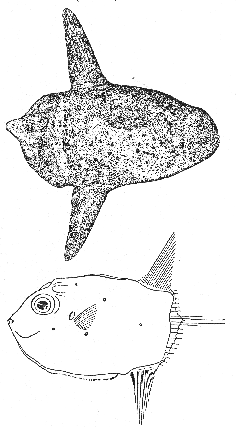Sharp-tailed sunfish Masturus lanceolatus (Liénard) 1840 [29]

Figure 283.—Sharp-tailed sunfish (Masturus lanceolatus). Above, adult, Miami, Florida, after Gudger. Below, young, 54 mm., Massachusetts Bay, after Putnam.
Description—
The sharp-tailed sunfish differs from the common sunfish (Mola mola) chiefly in the fact that the rear margin of its body is edged by a short but evident caudal fin of 18-20 soft rays, that extends around from close behind the dorsal fin to close behind the anal fin, with a triangular lobelike, blunt-tipped projection a little above the midlevel of the body. Its scales, too, are much finer and less evident to the touch than those of Mola, and its skin is less slimy. It resembles Mola very closely in all other respects.
Color—
Described as with the whole trunk more or less silvery, the upper parts of the sides grayish brown to blackish, the lower parts paler; the sides either plain or variously marked with ill-defined dark spots; the dorsal and anal fins as dark slaty, the caudal fin as sometimes with pale blotches.
Size—
This sunfish appears to grow as large as the more common Mola, perhaps even larger. In a Florida specimen, 88 inches long (after being dried somewhat) the tail fin occupied 21 inches, the body occupied 67 inches and was 38 inches high.[30] The dimensions of a North Carolina specimen 73½ inches long were: body 54½ inches long by 37 inches high and 11 inches thick, tail fin 19 inches long, dorsal fin 27 inches high, anal fin 25 inches high.[31]
Habits—
Nothing is known of its habits to differentiate it from its more common relative.
General range—
This sunfish, like Mola, appears to be cosmopolitan in tropical-warm temperate latitudes, oceanic in nature but coming close inshore on occasion, and even into estuarine situations. Adults have been reported from Japan, the Hawaiian Islands, Polynesia, Amboina, and Mauritius in the Indian and Pacific Oceans; from the Red Sea; from South Africa (Table Bay); from Madeira, from near the Azores; near Havana, Cuba (7 specimens); east coast of Florida (9 specimens), and North Carolina (4 specimens) in the Atlantic. Young fry have been taken off the Azores; in the Sargasso Sea; west of the Canaries; in the Caribbean; and in the Gulf of Mexico.[32]
Occurrence in the Gulf of Maine—
The only record for the sharp-tailed sunfish for our Gulf is for 4 young fry, about 2 inches long, that were taken many years ago in Massachusetts Bay. These were originally reported by Putnam[33] as the young of the common ocean sunfish, but Schmidt[34] and Gudger[35] have shown that they were the sharp-tailed species in reality, because with projecting caudal fins. The nearest locality record for an adult of the species (to date) is for Pamlico Sound, N. C. But it would not be astonishing if one were to drift farther northward any summer, as so many stray species do from the south.
[29] It is an open question still, whether specimens with longer tail fins and others with shorter tail fins represent two separate species, or whether the differences between them are sexual ones. See Fraser-Brunner (Bull. British Mus. Nat. Hist., vol. 1, No. 6, 1951, p. 105) for a recent discussion of this subject.
[30] Hubbs and Giovanneli, Copeia, 1931, pp. 135-136.
[31] Brimley, Jour. Elisha Mitchell Sci. Soc., vol. 55, 1939, p. 295.
[32] See Gudger (Proc. Zool. Soc. London, 1937, Ser. A, p. 353), for list of locality records up to 1937 with references; Brimley (Jour. Elisha Mitchell Sci. Soc., vol. 55, 1939, p. 295) for account of North Carolina specimens.
[33] Proc. Amer. Assoc. Advancement of Science, 19th meeting, Troy, N. Y. (1870) 1871, pp. 255-256.
[34] Meddel. Komm. Havundersøgelser, Denmark, Ser. Fiskeri, vol. 6, Pt. 6. 1921, p. 6.
[35] Proc. Zool. Soc. London, 1937, Ser. A, p. 382.